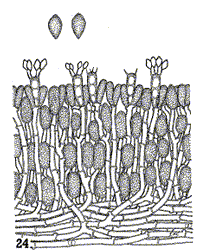|
 Corticium pteridophilum Corticium pteridophilum
BiostatusPresent in region - Indigenous
Images (click to enlarge)
Caption: FIG. 24. Corticium pteridophilum. Showing the oval or elliptical gloeocystidia
occupying the bulk of the intermediate layer, and broadly fusiform spores. |
Article: Stalpers, J.A. (1985). Type studies of the species of Corticium described by G.H. Cunningham. New Zealand Journal of Botany 23(2): 301-310 (http://www.rsnz.org/publish/abstracts.php).
Notes: The type material is in bad condition. No basidia or spores as described by Cunningham were
found. Some collapsed amyloid warted basidiospores (about 4 µm long) were seen, but these
are probably extraneous. Cunningham compared C. pteridophilum with Gloeocystidium
cretatum Bourd. & Galz., which is the type species of Parvobasidium Jlich. It may well
belong to this genus, but additional material should be studied before a transfer can be made.
The species seems to cause a brown rot.
Article: Cunningham, G.H. (1963). The Thelephoraceae of Australia and New Zealand. New Zealand Department of Scientific and Industrial Research, Bulletin 145: 359 p. Wellington:.
Description: Hymenophore annual, membranous, adherent, effused forming linear areas 8-20 x 1-2 cm; hymenial
surface pallid cream, even, not creviced; margin thinning out,
arachnoid, white, adherent. Context white, 50-110 µ thick, basal layer narrow, of
intertwined or parallel hyphae, intermediate layer of mainly erect hyphae cemented
and embedding numerous gloeocystidia and masses of crystals; generative hyphae
3-3.5 µ diameter, walls 0.1 µ thick, naked, with clamp connections.
Gloeocystidia
arranged in several irregular rows in context and hymenium, elongate-oblong, oval,
obovate, or clavate, not projecting, 12-20 x 7-9 µ. Hymenial layer a scanty palisade
of basidia, paraphyses, and gloeocystidia. Basidia cylindrical or cucurbitiform, 12-20 x 5-6 µ,
bearing 2-4 spores; sterigmata arcuate, slender, to 5 µ long. Paraphyses
subclavate, 10-15 x 4-5 µ. Spores broadly fusiform with acuminate ends, sometimes
slightly flattened on one side, apiculate, 7-9 x 4-4.5 µ, walls smooth, hyaline, 0.1 µ
thick; often adhering in pairs or fours.
Habitat: HABITAT: Pendent dead stipes of tree ferns.
Distribution: TYPE LOCALITY: Kauaeranga Valley, Auckland, New Zealand.
DISTRIBUTION: New Zealand.
Notes: C. pteridophilum is one of three species growing upon dead pendent stipes of tree
ferns. From the others, C. confusum and C. filicinum, it is separated by the
gloeocystidia and broadly fusiform spores. In shape and arrangement of the small
gloeocystidia the species resembles C. lianacolum, differing in the broadly fusiform
spores and membranous hymenophore. It has similar gloeocystidia and habitat to
`Gloeocystidium' cretatum Bourd. & Galz., from which it is separated by the much
larger spores of different shape, and wider basidia. Crystals may be present in or
absent from different parts of the same specimen; when present they are packed in an
irregular zone in the intermediate layer.
|